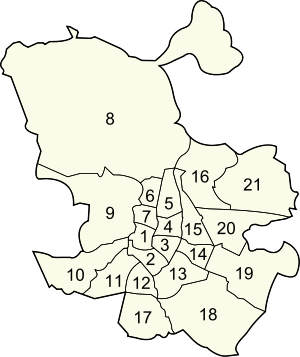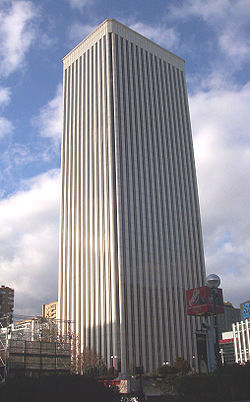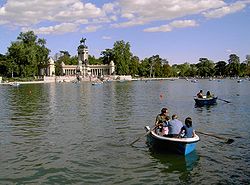- Districts of Madrid
-
Madrid, the capital city of Spain, is politically organized with a division in 21 districts (distritos), which are further subdivided into 128 wards (barrios):.[1] All districts are governed by an organ named Junta Municipal de Distrito.
Contents
Administrative division
Madrid is divided into 21 districts (distritos) and 129 wards (barrios).
Districts and wards
- Centro: Palacio, Embajadores, Cortes, Justicia, Universidad, Sol.
- Arganzuela: Imperial, Acacias, La Chopera, Legazpi, Delicias, Palos de Moguer, Atocha.
- Retiro: Pacífico, Adelfas, Estrella, Ibiza, Jerónimos, Niño Jesús.
- Salamanca: Recoletos, Goya, Parque de las Avenidas, Fuente del Berro, Guindalera, Lista, Castellana.
- Chamartín: El Viso, Prosperidad, Ciudad Jardín, Hispanoamérica, Nueva España, Castilla.
- Tetuán: Bellas Vistas, Cuatro Caminos, Castillejos, Almenara, Valdeacederas, Berruguete.
- Chamberí: Gaztambide, Arapiles, Trafalgar, Almagro, Vallehermoso, Ríos Rosas.
- Fuencarral-El Pardo: El Pardo, Fuentelarreina, Peñagrande, Barrio del Pilar, La Paz, Valverde, Mirasierra, El Goloso.
- Moncloa-Aravaca: Casa de Campo, Argüelles, Ciudad Universitaria, Valdezarza, Valdemarín, El Plantío, Aravaca.
- Latina: Los Cármenes, Puerta del Ángel, Lucero, Aluche, Las Águilas, Campamento, Cuatro Vientos.
- Carabanchel: Abrantes, Buenavista, Comillas, Opañel, Puerta Bonita, San Isidro, Vista Alegre.
- Usera: Orcasitas, Orcasur, San Fermín, Almendrales, Moscardó, Zofío, Pradolongo.
- Puente de Vallecas: Entrevías, San Diego, Palomeras Bajas, Palomeras Sureste, Portazgo, Numancia.
- Moratalaz: Pavones, Horcajo, Marroquina, Media Legua, Fontarrón, Vinateros.
- Ciudad Lineal: Ventas, Pueblo Nuevo, Quintana, La Concepción, San Pascual, San Juan Bautista, Colina, Atalaya, Costillares.
- Hortaleza: Palomas, Valdefuentes, Canillas, Pinar del Rey, Apóstol Santiago, Piovera.
- Villaverde: San Andrés, San Cristóbal, Butarque, Los Rosales, Los Ángeles.
- Villa de Vallecas: Casco Histórico de Vallecas, Santa Eugenia.
- Vicálvaro: Casco Histórico de Vicálvaro, Ambroz.
- San Blas: Simancas, Hellín, Amposta, Arcos, Rosas, Rejas, Canillejas, Salvador.
- Barajas: Alameda de Osuna, Aeropuerto, Casco Histórico de Barajas, Timón, Corralejos.
Popular Neighbourhoods
 Bank of Spain building (foreground) and Palacio de Comunicaciones building (background) at the center of Madrid
Bank of Spain building (foreground) and Palacio de Comunicaciones building (background) at the center of Madrid
Contemporary Madrid came into its own after the death of general Francisco Franco. With his death, Madrid, and Spain as a whole, began to reassert itself on the international stage. Within Spain, reaction against the dictatorial bureaucracy centered in Madrid and a history of centralism that predated Franco by centuries has resulted in the successful modern movement towards increased autonomy for the regions of Spain, considered as autonomous regions, under the umbrella of Spain.
Modern Madrid ranks as one of the most important cities in Europe. Madrid is a leading southern European city and the most important link between the European Union and Latin America.
The modern metropolis is home to over three million people. As expected with any major European capital city, each district (or barrio in Spanish) has its own feel. Some of the most well-known "barrios" in Madrid are:
- Alonso Martínez
- This district contains the large Plaza de Colón. This plaza commemorates Christopher Columbus, who was responsible for ushering in the Spanish imperial golden age of the 16th and 17th centuries. It is within walking distance of the main cultural and commercial areas of the city such as the Prado museum, the expansive Parque del Buen Retiro as well as near the business center on the lower part of the Paseo de la Castellana.
- Atocha
- Atocha includes a rather large area which is bordered by the Huertas and Lavapiés districts. The two important sites located in this area are the Reina Sofía Museum and the Atocha Railway Station (which was the main object of the terrorist attacks carried out on March 11, 2004), one of the two main train stations in Madrid (the other one is Chamartín). The area also contains a number of art galleries and restaurants serving traditional food. This district also contains the main bus terminal as it is a central point of the city. In addition, Atocha was the site of the 1977 Massacre of Atocha.
- AZCA / Nuevos Ministerios
- Azca is the financial district. The area is populated by skyscrapers, among them Torre Picasso–157 metres (515 ft), Edificio BBVA–107 metres (351 ft) and Torre Europa–115 metres (377 ft). Torre Windsor, one of the skyscrapers in this area, burnt entirely on the night between 12th and 13 February 2005 [1]. A very large (3 interconnected buildings) El Corte Inglés department store is also here. The area is directly linked to Barajas Airport by metro line 8 from Nuevos Ministerios station. It's the Parkour centre of Madrid.
- CTBA (Cuatro Torres Business Area)
- The CTBA is the new financial district of Madrid, the area will be composed by four skyscrapers. The tallest of them is the Repsol tower (250 m/820 ft), designed by Sir Norman Foster. When they finish the construction of the building, it will be the tallest skyscraper in Spain and the 3rd in Europe. The second tallest skyscraper,'Crystal Tower', is only 0.6 metres (2 ft) lower than Repsol tower, with 249.4 metres (818.2 ft), it will be the 4th tallest skyscraper of Europe. This building has being designed by Cesar Pelli. The third tallest skyscraper is the 'Sacyr-Vallehermoso' tower with 235 metres (771 ft) and designed by Enrique Alvarez & Carlos Rubio. This building will have a 5 star hotel on the first 31 floors and will be the 5th tallest tower in Europe. Finally, the fourth building will be 'Espacio tower'. It is 223 metres (732 ft) long and it is designed by I.M. Pei. The four skyscrapers will be finished during 2008.[2] Currently, the tallest tower is the 'Espacio Tower' because it is more advanced in construction than the other three towers.
- Chueca
- Chueca is known as the main gay village of Madrid
Main article: Chueca- Las Cortes
- This district is small in size. The most important sites include Spanish parliament buildings of the lower house Congreso de los Diputados. It also includes one of the three museums of the Madrid golden triangle, the Thyssen-Bornemisza Museum. In addition, we find the highly ornate Banco de España, the Café del Círculo de Bellas Artes, the Zarzuela theater and the Plaza de Cibeles.
- Huertas
- (or Barrio de las letras) A neighborhood west of Paseo del Prado, north of Calle Atocha. Famous for being the "literary" neighborhood of Madrid where many famous writers lived or spent their free time. One of the prominent landmarks is the house of Cervantes where he died in 1616. In the last years, it became a nightlife mecca with thousands of Madrileños and tourists walking around and bar-hopping along Calle de las Huertas and Plaza Santa Ana. The latter is now a major nightlife spot.
- Gran Vía
- As the name implies, the Gran Vía district contains one of Madrid's most important avenues, the Gran Vía (literally, "Great Way"). First and foremost it is a shopping street; however it also contains a number of tourist accommodations, plenty of nightlife (all of Madrid's large goth scene gravitates around Gran Via, for instance), many of Madrid's largest movie theaters and live musical shows. It is also a hub for Madrid's red-light district, linking as it does many side streets. One of these streets, Fuencarral has become a link between the old shopping areas of the center of the city, the Bohemian Malasaña, and the hip Chueca district, making of it one of the most cosmopolitan areas of the city.
- Lavapiés
- Traditionally one of the poorer neighborhoods near the city center, this district has maintained much of true 'Madrileño' spirit of the past. Lavapiés is one of the areas with a high concentration of immigrants (mainly Chinese, Arabs, Hindi, Africans and Caribbeans), and also tends to attract artists and writers adding to the cosmopolitan mix. The presence of immigrants has led to an inevitable variety of shops and restaurants - this is a good place for good and cheap restaurants of local and international food. It's also one of the best places to search for non-Spanish foodstuff, (herbs and spices etc.)
- La Latina
- In and around this area are the origins of Madrid. Its difficult to put precise boundaries on La Latina, because, like its immediate neighbors, streets are narrow and winding. There are quite a few nightlife spots, though the neighborhood is best known as having one of the best concentrations of tapas bars (particularly on the Cava Baja and Cava Alta). There are also a number of attractive churches, like the Iglesia de San Andres and the Iglesia de San Francisco el Grande,. On Sundays and major holidays, the famous Rastro flea-market begins on the eastern edge of La Latina, spilling out of the San Millan exit of the La Latina metro stop to the Plaza de Cascorro all the way to the Ronda de Toledo to the south. Plaza de la Paja is another interesting and entertaining spot of this neighborhood. On the other side, La Latina borders with Plaza Mayor and another ancient part of the town, Los Austrias, where you can find the beautiful Palacio Real (Royal Palace).
- Malasaña
- This neighbourhood is famous for its nightlife, and for having been the main hub of the Movida in the 70s and 80s.
Main article: Malasaña- Opera
- As the name implies, Madrid's main Opera Theatre is the Teatro Real (Royal theatre). In front of the theatre is the Royal Palace. The Royal Palace is no longer used as a residence, but it has been kept intact since it last functioned as home to the King, serving as a cultural monument and occasionally used for state functions. The entire palace is not open to the public, but most of the more important rooms can be visited. The palace is interesting in its own right, in particular its architecture and gardens (there are two, the Jardines del Moro and the Sabattini gardens). There are also some excellent frescos inside the palace by Tiépolo, and paintings by Velázquez, Goya, Rubens, El Greco, Juan de Flandes and Caravaggio, among others. This palace is known for being one of larger palaces in Europe; it's actually larger than Versailles Palace.
- Retiro
- Barrio Retiro is a classic neighborhood surrounding the famous Retiro Park, to the east of the center of the city. It is demographically the oldest neighborhood in the city, however over the past 5 years the increasing number of flats put for rent have been attracting young people and students to the area in growing numbers, and the diversity of the gastronomical fare in the neighborhood reflects this. The neighborhood can be characterized by the style of its three most important areas; in the north part centering on the calle Ibiza, the streets are in a grid pattern and the buildings, normally 6-10 storeys, are packed closely together, creating a bustling atmosphere of small shops, bars, and restaurants. This area is very similar to the neighborhing Salamanca neighborhood. In the south, called Niño Jesus, the area is quieter, more spacious, and residential. To the west of the park (but still included within the parameters of Barrio Retiro) is the Jerónimos area, an area of beautiful 18th and 19th century buildings and many museums (including the Prado). This area, however, has few private residences, the large flats (often above 200 m²/2,150 sq ft) being mainly used for offices. Main article on Retiro Park: Retiro
- Hortaleza
- Is a residential district in the north. There's the Spanish Olympic Committee, the IFEMA (New Madrid Expo) and Juan Carlos I Park, a beautiful park between Campo de las Naciones (Commercial District inside Hortaleza) and Barajas. Mar de Cristal is the most important tube station in Hortaleza district because it's an airport connection.
- Vallecas
- Vallecas is a working-class residential district in the south of Madrid. It is also home to the Rayo Vallecano soccer team.
- Aravaca
- Aravaca is an upper-class residential suburb in the northwest of Madrid. During the Spanish Civil War the front was stabilized here for almost three years. Aravaca and its surroundings are plenty of parks and woods like Casa de Campo.
References
- ^ "División Administrativa de Madrid". Verdad-11M. July 9, 2006. http://es.wikipedia.org/wiki/Madrid.
- ^ "La mayor obra de rascacielos de Europa.". CincoDias.com. August 21, 2006. http://www.cincodias.com/articulo/empresas/rascacielos/nuevo/centro/financiero/Madrid/despuntan/cdscdi/20060102cdscdiemp_3/Tes/.
External links
 Media related to Districts of Madrid at Wikimedia Commons
Media related to Districts of Madrid at Wikimedia CommonsDistricts and wards of Madrid Arganzuela Atocha • Imperial • La Chopera • Las Acacias • Las Delicias • Legazpi • Palos de Moguer

Barajas Aeropuerto • Alameda de Osuna • Casco Histórico de Barajas • Corralejos • TimónCarabanchel Abrantes • Buenavista • Comillas • Opañel • Puerta Bonita • San Isidro • Vista AlegreCentro Cortes • Embajadores • Justicia • Malasaña • Palacio • SolChamartín Castilla • Ciudad Jardín • El Viso • Hispanoamérica • Nueva España • ProsperidadChamberí Almagro • Arapiles • Joaquín Gaztambide • Ríos Rosas • Trafalgar • VallehermosoCiudad Lineal Atalaya • Colina • Concepción • Pinar de Chamartín • Pueblo Nuevo • Quintana • San Juan Bautista • San Pascual • VentasFuencarral-El Pardo Barrio del Pilar • El Goloso • El Pardo • Fuentelarreina • La Paz • Mirasierra • Peñagrande • ValverdeHortaleza Apóstol Santiago • Canillas • Palomas • Pinar del Rey • Piovera • ValdefuentesLatina Aluche • Campamento • Cuatro Vientos • Las Águilas • Lucero • Los Cármenes • Puerta del ÁngelMoncloa-Aravaca Aravaca • Argüelles • Casa de Campo • Ciudad Universitaria • El Plantío • Valdemarín • ValdezarzaMoratalaz Fontarrón • Horcajo • Marroquina • Media Legua • Pavones • VinaterosPuente de Vallecas Entrevías • Numancia • Palomeras Bajas • Palomeras Sureste • Portazgo • San DiegoRetiro Adelfas • Estrella • Ibiza • Jerónimos • Niño Jesús • PacíficoSalamanca Castellana • Fuente del Berro • Goya • Guindalera • Lista • Parque de las Avenidas • RecoletosSan Blas Amposta • Arcos • Canillejas • Hellín • Rejas • Rosas • Salvador • SimancasTetuán Almenara • Bellas Vistas • Berruguete • Castillejos • Cuatro Caminos • ValdeacederasUsera Almendrales • Moscardó • Orcasitas • Orcasur • Pradolongo • San Fermín • ZofíoVicálvaro Ambroz • Casco Histórico de VicálvaroVilla de Vallecas Casco Histórico de Vallecas • Santa EugeniaCategories:
Wikimedia Foundation. 2010.





